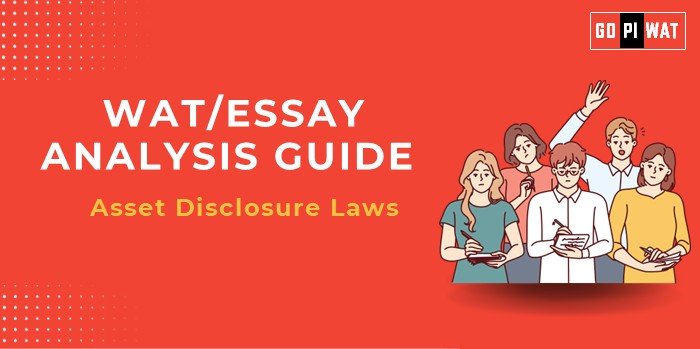📋 Written Ability Test (WAT)/Essay Analysis Guide: Asset Disclosure Laws
🌐 Understanding the Topic
Asset disclosure laws reflect the growing demand for transparency in governance. Their implementation is closely tied to reducing corruption, improving public trust, and fostering accountability, aligning with global trends.
📝 Effective Planning and Writing
- ⏱️ Time Allocation:
- Planning: 5 minutes.
- Writing: 20 minutes.
- Review: 5 minutes.
- 📋 Word Count Distribution (500 words):
- Introduction: 70 words.
- Body: 350 words.
- Conclusion: 70 words.
💡 Introduction Techniques for Essays
- ⚖️ Contrast Approach: “Countries with asset disclosure laws rank 30% higher on the Corruption Perception Index, but compliance globally remains below 40%, reflecting an urgent need for reform.”
- 💡 Solution-Based Approach: “Mandatory asset declarations combat corruption effectively but need robust systems to address compliance gaps and privacy concerns.”
- 📜 Historical Context Approach: “From Denmark’s success on the CPI to India’s Lokpal Act challenges, asset disclosure laws are both critical and contested.”
📚 Structuring the Essay Body
🏆 Achievements
- ✅ Higher CPI Scores: Countries with robust disclosure laws rank 30% higher on the Corruption Perception Index (CPI).
- 🇮🇳 India’s Progress: 70% compliance under the Lokpal Act demonstrates improvement.
⚠️ Challenges with Comparative Analysis
- 📉 Low Global Compliance: Compliance with asset disclosure laws remains below 40% globally.
- 🔒 Privacy Concerns: Estonia’s encrypted systems are a model, while India faces ongoing challenges.
🔮 Future Outlook
- 💻 Recommendations for digital disclosure systems and improved enforcement mechanisms.
📄 Concluding Effectively
- ⚖️ Balanced Perspective Conclusion: “Asset disclosure laws are vital for ethical governance, but their success hinges on bridging compliance gaps and protecting privacy.”
- 🌍 Global Comparison Conclusion: “Estonia’s success in balancing transparency with privacy demonstrates how digital innovation can transform asset disclosure systems worldwide.”
📊 Analyzing Successes and Shortcomings
🌟 Key Achievements
- ✅ Higher CPI rankings.
- 🌍 Increased public trust in governance.
- 🇮🇳 Policy compliance improvements in India under the Lokpal Act.
⚠️ Ongoing Challenges
- 🔒 Privacy risks associated with mandatory disclosures.
- 📉 Low compliance rates globally.
- ⚖️ Enforcement issues in implementation.
🌍 Global Context
- 🇩🇰 Denmark as a leader in asset disclosure success, reflected in high CPI rankings.
- 🇪🇪 Estonia’s innovative digital solutions for asset disclosures.
✨ Recommendations for Sustainable Progress
- 🔒 Adopt Encrypted Digital Systems: Ensure transparency while protecting privacy.
- 🌐 Strengthen Global Partnerships: Collaborate to monitor compliance and enforcement.
- 📢 Enhance Public Awareness: Educate citizens on the benefits of asset disclosure for governance.
✍️ Sample Short Essays
⚖️ Balanced Perspective:
“Asset disclosures ensure accountability but require stronger privacy safeguards to achieve widespread compliance.”
💡 Solution-Oriented:
“Digital innovations like Estonia’s systems can address challenges of transparency and compliance in asset disclosures.”
🌍 Global Comparison:
“Denmark’s CPI success highlights the importance of robust disclosure systems, a model India and others can emulate.”


